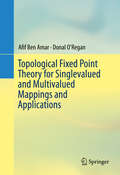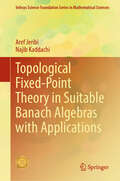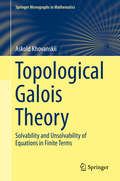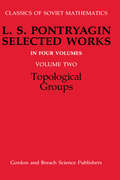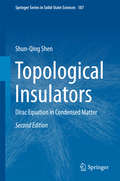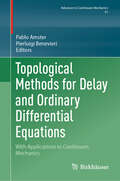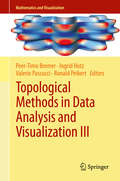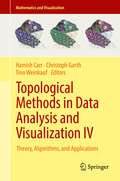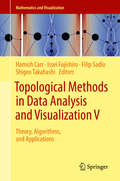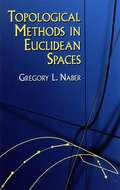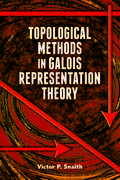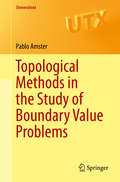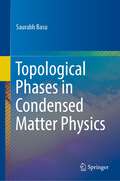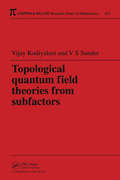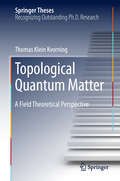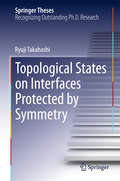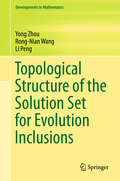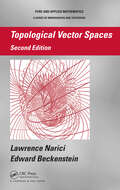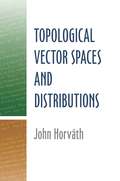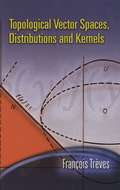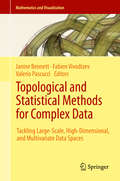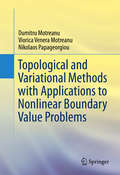- Table View
- List View
Topological Fixed Point Theory for Singlevalued and Multivalued Mappings and Applications
by Afif Ben Amar Donal O'ReganThis is a monograph covering topological fixed point theory for several classes of single and multivalued maps. The authors begin by presenting basic notions in locally convex topological vector spaces. Special attention is then devoted to weak compactness, in particular to the theorems of Eberlein-Smulian, Grothendick and Dunford-Pettis. Leray-Schauder alternatives and eigenvalue problems for decomposable single-valued nonlinear weakly compact operators in Dunford-Pettis spaces are considered, in addition to some variants of Schauder, Krasnoselskii, Sadovskii, and Leray-Schauder type fixed point theorems for different classes of weakly sequentially continuous operators on general Banach spaces. The authors then proceed with an examination of Sadovskii, Furi-Pera, and Krasnoselskii fixed point theorems and nonlinear Leray-Schauder alternatives in the framework of weak topologies and involving multivalued mappings with weakly sequentially closed graph. These results are formulated in terms of axiomatic measures of weak noncompactness. The authors continue to present some fixed point theorems in a nonempty closed convex of any Banach algebras or Banach algebras satisfying a sequential condition (P) for the sum and the product of nonlinear weakly sequentially continuous operators, and illustrate the theory by considering functional integral and partial differential equations. The existence of fixed points, nonlinear Leray-Schauder alternatives for different classes of nonlinear (ws)-compact operators (weakly condensing, 1-set weakly contractive, strictly quasi-bounded) defined on an unbounded closed convex subset of a Banach space are also discussed. The authors also examine the existence of nonlinear eigenvalues and eigenvectors, as well as the surjectivity of quasibounded operators. Finally, some approximate fixed point theorems for multivalued mappings defined on Banach spaces. Weak and strong topologies play a role here and both bounded and unbounded regions are considered. The authors explicate a method developed to indicate how to use approximate fixed point theorems to prove the existence of approximate Nash equilibria for non-cooperative games. Fixed point theory is a powerful and fruitful tool in modern mathematics and may be considered as a core subject in nonlinear analysis. In the last 50 years, fixed point theory has been a flourishing area of research. As such, the monograph begins with an overview of these developments before gravitating towards topics selected to reflect the particular interests of the authors.
Topological Fixed-Point Theory in Suitable Banach Algebras with Applications (Infosys Science Foundation Series)
by Aref Jeribi Najib KaddachiThis book delves into the topics of fixed-point theory as applied to block operator matrices within the context of Banach algebras featuring multi-valued inputs. Its scope extends to a broad range of equations, encompassing nonlinear biological models as well as two-dimensional boundary value problems associated with burgeoning cell populations and functional systems of differential and integral inclusions. The book systematically introduces the principles of topological fixed-point theory, offering insights into various classes of both single-valued and multi-valued maps. The overarching goal is to disseminate key techniques and outcomes derived from fixed-point theory, with a specific emphasis on its application to both single-valued and multi-valued mappings within the framework of Banach algebras.
Topological Galois Theory
by Askold KhovanskiiThis book provides a detailed and largely self-contained description of various classical and new results on solvability and unsolvability of equations in explicit form. In particular, it offers a complete exposition of the relatively new area of topological Galois theory, initiated by the author. Applications of Galois theory to solvability of algebraic equations by radicals, basics of Picard-Vessiot theory, and Liouville's results on the class of functions representable by quadratures are also discussed. A unique feature of this book is that recent results are presented in the same elementary manner as classical Galois theory, which will make the book useful and interesting to readers with varied backgrounds in mathematics, from undergraduate students to researchers. In this English-language edition, extra material has been added (Appendices A-D), the last two of which were written jointly with Yura Burda.
Topological Groups
by R.V. GamkrelidzeOffering the insights of L.S. Pontryagin, one of the foremost thinkers in modern mathematics, the second volume in this four-volume set examines the nature and processes that make up topological groups. Already hailed as the leading work in this subject for its abundance of examples and its thorough explanations, the text is arranged so that readers can follow the material either sequentially or schematically. Stand-alone chapters cover such topics as topological division rings, linear representations of compact topological groups, and the concept of a lie group.
Topological Indices and Related Descriptors in QSAR and QSPR
by James Devillers Alexandru T. BalabanTopological Indices and Related Descriptors in QSAR and QSPR reviews the state of the art in this field and highlights the important advances in the generation of descriptors calculated directly from the structure of molecules. This long-awaited comprehensive book provides all the necessary information to calculate and use these descriptors for deriving structure-activity and structure-property relationships. Written by leading experts in the field, this book discusses the physicochemical significance, strengths, and weaknesses of these indices and presents numerous examples of applications. This book will be a valuable reference for anyone involved in the use of QSAR and QSPR in the pharmaceutical, applied chemical, and environmental sciences. It is also suitable for use as a supplementary textbook on related graduate level courses.
Topological Insulators
by Shun-Qing ShenTopological insulators are insulating in the bulk, but process metallic states present around its boundary owing to the topological origin of the band structure. The metallic edge or surface states are immune to weak disorder or impurities, and robust against the deformation of the system geometry. This book, the first of its kind on topological insulators, presents a unified description of topological insulators from one to three dimensions based on the modified Dirac equation. A series of solutions of the bound states near the boundary are derived, and the existing conditions of these solutions are described. Topological invariants and their applications to a variety of systems from one-dimensional polyacetalene, to two-dimensional quantum spin Hall effect and p-wave superconductors, and three-dimensional topological insulators and superconductors or superfluids are introduced, helping readers to better understand this fascinating new field. This book is intended for researchers and graduate students working in the field of topological insulators and related areas. Shun-Qing Shen is a Professor at the Department of Physics, the University of Hong Kong, China.
Topological Methods for Delay and Ordinary Differential Equations: With Applications to Continuum Mechanics (Advances in Mechanics and Mathematics #51)
by Pablo Amster Pierluigi BenevieriThis volume explores the application of topological techniques in the study of delay and ordinary differential equations with a particular focus on continuum mechanics. Chapters, written by internationally recognized researchers in the field, present results on problems of existence, multiplicity localization, bifurcation of solutions, and more. Topological methods are used throughout, including degree theory, fixed point index theory, and classical and recent fixed point theorems. A wide variety of applications to continuum mechanics are provided as well, such as chemostats, non-Newtonian fluid flow, and flows in phase space. Topological Methods for Delay and Ordinary Differential Equations will be a valuable resource for researchers interested in differential equations, functional analysis, topology, and the applied sciences.
Topological Methods in Data Analysis and Visualization III
by Peer-Timo Bremer Ingrid Hotz Valerio Pascucci Ronald PeikertThis collection of peer-reviewed conference papers provides comprehensive coverage of cutting-edge research in topological approaches to data analysis and visualization. It encompasses the full range of new algorithms and insights, including fast homology computation, comparative analysis of simplification techniques, and key applications in materials and medical science. The volume also features material on core research challenges such as the representation of large and complex datasets and integrating numerical methods with robust combinatorial algorithms. Reflecting the focus of the TopoInVis 2013 conference, the contributions evince the progress currently being made on finding experimental solutions to open problems in the sector. They provide an inclusive snapshot of state-of-the-art research that enables researchers to keep abreast of the latest developments and provides a foundation for future progress. With papers by some of the world's leading experts in topological techniques, this volume is a major contribution to the literature in a field of growing importance with applications in disciplines that range from engineering to medicine.
Topological Methods in Data Analysis and Visualization IV
by Hamish Carr Christoph Garth Tino WeinkaufThis book presents contributions on topics ranging from novel applications of topological analysis for particular problems, through studies of the effectiveness of modern topological methods, algorithmic improvements on existing methods, and parallel computation of topological structures, all the way to mathematical topologies not previously applied to data analysis. Topological methods are broadly recognized as valuable tools for analyzing the ever-increasing flood of data generated by simulation or acquisition. This is particularly the case in scientific visualization, where the data sets have long since surpassed the ability of the human mind to absorb every single byte of data. The biannual TopoInVis workshop has supported researchers in this area for a decade, and continues to serve as a vital forum for the presentation and discussion of novel results in applications in the area, creating a platform to disseminate knowledge about such implementations throughout and beyond the community. The present volume, resulting from the 2015 TopoInVis workshop held in Annweiler, Germany, will appeal to researchers in the fields of scientific visualization and mathematics, domain scientists with an interest in advanced visualization methods, and developers of visualization software systems.
Topological Methods in Data Analysis and Visualization V: Theory, Algorithms, and Applications (Mathematics and Visualization)
by Hamish Carr Issei Fujishiro Filip Sadlo Shigeo TakahashiThis collection of peer-reviewed workshop papers provides comprehensive coverage of cutting-edge research into topological approaches to data analysis and visualization. It encompasses the full range of new algorithms and insights, including fast homology computation, comparative analysis of simplification techniques, and key applications in materials and medical science. The book also addresses core research challenges such as the representation of large and complex datasets, and integrating numerical methods with robust combinatorial algorithms. In keeping with the focus of the TopoInVis 2017 Workshop, the contributions reflect the latest advances in finding experimental solutions to open problems in the sector. They provide an essential snapshot of state-of-the-art research, helping researchers to keep abreast of the latest developments and providing a basis for future work. Gathering papers by some of the world’s leading experts on topological techniques, the book represents a valuable contribution to a field of growing importance, with applications in disciplines ranging from engineering to medicine.
Topological Methods in Euclidean Spaces
by Gregory L. NaberExtensive development of a number of topics central to topology, including elementary combinatorial techniques, Sperner's Lemma, the Brouwer Fixed Point Theorem, homotopy theory and the fundamental group, simplicial homology theory, the Hopf Trace Theorem, the Lefschetz Fixed Point Theorem, the Stone-Weierstrass Theorem, and Morse functions. Includes new section of solutions to selected problems.
Topological Methods in Galois Representation Theory (Dover Books on Mathematics)
by Prof. Victor P. SnaithThis advanced monograph on Galois representation theory was written by one of the world's leading algebraists. Directed at mathematics students who have completed a graduate course in introductory algebraic topology, it offers a full treatment of the subject. The first four chapters cover characteristic classes of Galois representations whose values lie in mod 2 Galois cohomology: abelian cohomology of groups, nonabelian cohomology of groups, characteristic classes of forms and algebras, and higher-dimensional characteristic classes of bilinear forms and Galois representations. Subsequent chapters explore stable homotopy and induced representations, explicit Brauer induction theory, and applications of explicit Brauer induction to Artin root numbers and local root numbers.
Topological Methods in Group Theory (London Mathematical Society Lecture Note Series #451)
by J. F. Lafont N. Broaddus M. Davis I. J. OrtizThis volume collects the proceedings of the conference 'Topological methods in group theory', held at Ohio State University in 2014 in honor of Ross Geoghegan's 70th birthday. It consists of eleven peer-reviewed papers on some of the most recent developments at the interface of topology and geometric group theory. The authors have given particular attention to clear exposition, making this volume especially useful for graduate students and for mathematicians in other areas interested in gaining a taste of this rich and active field. A wide cross-section of topics in geometric group theory and topology are represented, including left-orderable groups, groups defined by automata, connectivity properties and Σ-invariants of groups, amenability and non-amenability problems, and boundaries of certain groups. Also included are topics that are more geometric or topological in nature, such as the geometry of simplices, decomposition complexity of certain groups, and problems in shape theory.
Topological Methods in the Study of Boundary Value Problems
by Pablo AmsterThis textbook is devoted to the study of some simple but representative nonlinear boundary value problems by topological methods. The approach is elementary, with only a few model ordinary differential equations and applications, chosen in such a way that the student may avoid most of the technical difficulties and focus on the application of topological methods. Only basic knowledge of general analysis is needed, making the book understandable to non-specialists. The main topics in the study of boundary value problems are present in this text, so readers with some experience in functional analysis or differential equations may also find some elements that complement and enrich their tools for solving nonlinear problems. In comparison with other texts in the field, this one has the advantage of a concise and informal style, thus allowing graduate and undergraduate students to enjoy some of the beauties of this interesting branch of mathematics. Exercises and examples are included throughout the book, providing motivation for the reader.
Topological Phases in Condensed Matter Physics
by Saurabh BasuThe book is mainly designed for post-graduate students to learn modern-day condensed matter physics. While emphasizing an experiment called the ‘Quantum Hall effect’, it introduces the subject of 'Topology' and how the topological invariants are related to the quantization of the Hall plateaus. Thus, the content tries to deliver an account of the topological aspects of materials that have shaped the study of condensed matter physics in recent times. The subject is often quite involved for a student to grasp the fundamentals and relate them to physical phenomena. Further, these topics are mostly left out of the undergraduate curriculum, although they often require a simplistic view of the concepts involved to be presented pedagogically. The book contains examples, worked-out concepts, important derivations, diagrams for illustration, etc. to aid the understanding of the students. The book also emphasizes the experimental discoveries that put the subject in its perspective and elaborate on the applications which are likely to be of interest to scientists and engineers.
Topological Quantum Field Theories from Subfactors (Chapman And Hall/crc Research Notes In Mathematics Ser. #Vol. 423)
by Vijay KodiyalamPure mathematicians have only recently begun a rigorous study of topological quantum field theories (TQFTs). Ocneanu, in particular, showed that subfactors yield TQFTs that complement the Turaev-Viro construction. Until now, however, it has been difficult to find an account of this work that is both detailed and accessible.Topological Quant
Topological Quantum Matter
by Thomas Klein KvorningThis book offers a theoretical description of topological matter in terms of effective field theories, and in particular topological field theories, focusing on two main topics: topological superconductors and topological insulators.Even though there is vast literature on these subjects, the book fills an important gap by providing a concise introduction to both topological order and symmetry-protected phases using a modern mathematical language, and developing the theoretical concepts by highlighting the physics and the physical properties of the systems. Further, it discusses in detail the topological interactions for topologically ordered matter, and the response to smooth external fields for symmetry protected matter. The book also covers more specialized topics that cannot be found elsewhere. Specifically, the response of superconductors to geometry, including the newly discovered geo-Meissner effect; and a correction to the usual Meissner effect, only present in the topologically interesting chiral superconductors.
Topological States on Interfaces Protected by Symmetry
by Ryuji TakahashiIn this book, the author theoretically studies two aspects of topological states. First, novel states arising from hybridizing surface states of topological insulators are theoretically introduced. As a remarkable example, the author shows the existence of gapless interface states at the interface between two different topological insulators, which belong to the same topological phase. While such interface states are usually gapped due to hybridization, the author proves that the interface states are in fact gapless when the two topological insulators have opposite chiralities. This is the first time that gapless topological novel interface states protected by mirror symmetry have been proposed. Second, the author studies the Weyl semimetal phase in thin topological insulators subjected to a magnetic field. This Weyl semimetal phase possesses edge states showing abnormal dispersion, which is not observed without mirror symmetry. The author explains that the edge states gain a finite velocity by a particular form of inversion symmetry breaking, which makes it possible to observe the phenomenon by means of electric conductivity.
Topological Structure of the Solution Set for Evolution Inclusions
by Yong Zhou Rong-Nian Wang Li PengThis book systematically presents the topological structure of solution sets and attractability for nonlinear evolution inclusions, together with its relevant applications in control problems and partial differential equations. It provides readers the background material needed to delve deeper into the subject and explore the rich research literature. In addition, the book addresses many of the basic techniques and results recently developed in connection with this theory, including the structure of solution sets for evolution inclusions with m-dissipative operators; quasi-autonomous and non-autonomous evolution inclusions and control systems; evolution inclusions with the Hille-Yosida operator; functional evolution inclusions; impulsive evolution inclusions; and stochastic evolution inclusions. Several applications of evolution inclusions and control systems are also discussed in detail. Based on extensive research work conducted by the authors and other experts over the past four years, the information presented is cutting-edge and comprehensive. As such, the book fills an important gap in the body of literature on the structure of evolution inclusions and its applications.
Topological Vector Spaces (Chapman & Hall/CRC Pure and Applied Mathematics)
by Lawrence Narici Edward BeckensteinWith many new concrete examples and historical notes, Topological Vector Spaces, Second Edition provides one of the most thorough and up-to-date treatments of the Hahn-Banach theorem. This edition explores the theorem's connection with the axiom of choice, discusses the uniqueness of Hahn-Banach extensions, and includes an entirely new chapter on v
Topological Vector Spaces and Distributions
by John HorvathMathematically rigorous but user-friendly, this classic treatise discusses major modern contributions to the field of topological vector spaces. The self-contained treatment includes complete proofs for all necessary results from algebra and topology. Suitable for undergraduate mathematics majors with a background in advanced calculus, this volume will also assist professional mathematicians, physicists, and engineers.The precise exposition of the first three chapters--covering Banach spaces, locally convex spaces, and duality--provides an excellent summary of the modern theory of locally convex spaces. The fourth and final chapter develops the theory of distributions in relation to convolutions, tensor products, and Fourier transforms. Augmented with many examples and exercises, the text includes an extensive bibliography.
Topological Vector Spaces, Distributions and Kernels: Pure And Applied Mathematics (Dover Books on Mathematics #Volume 25)
by Francois TrevesThis text for upper-level undergraduates and graduate students focuses on key notions and results in functional analysis. Extending beyond the boundaries of Hilbert and Banach space theory, it explores aspects of analysis relevant to the solution of partial differential equations.The three-part treatment begins with topological vector spaces and spaces of functions, progressing to duality and spaces of distribution, and concluding with tensor products and kernels. The archetypes of linear partial differential equations (Laplace's, the wave, and the heat equations) and the traditional problems (Dirichlet's and Cauchy's) are this volume's main focus. Most of the basic classical results appear here. There are 390 exercises, several of which contain detailed information that will enable readers to reconstruct the proofs of some important results.
Topological and Non-Topological Solitons in Scalar Field Theories (Cambridge Monographs on Mathematical Physics)
by Yakov M. ShnirSolitons emerge in various non-linear systems as stable localized configurations, behaving in many ways like particles, from non-linear optics and condensed matter to nuclear physics, cosmology and supersymmetric theories. This book provides an introduction to integrable and non-integrable scalar field models with topological and non-topological soliton solutions. Focusing on both topological and non-topological solitons, it brings together debates around solitary waves and construction of soliton solutions in various models and provides a discussion of solitons using simple model examples. These include the Kortenweg-de-Vries system, sine-Gordon model, kinks and oscillons, and skyrmions and hopfions. The classical field theory of scalar field in various spatial dimensions is used throughout the book in presentation of related concepts, both at the technical and conceptual level. Providing a comprehensive introduction to the description and construction of solitons, this book is ideal for researchers and graduate students in mathematics and theoretical physics.
Topological and Statistical Methods for Complex Data
by Valerio Pascucci Janine Bennett Fabien VivodtzevThis book contains papers presented at the Workshop on the Analysis of Large-scale, High-Dimensional, and Multi-Variate Data Using Topology and Statistics, held in Le Barp, France, June 2013. It features the work of some of the most prominent and recognized leaders in the field who examine challenges as well as detail solutions to the analysis of extreme scale data. The book presents new methods that leverage the mutual strengths of both topological and statistical techniques to support the management, analysis, and visualization of complex data. It covers both theory and application and provides readers with an overview of important key concepts and the latest research trends. Coverage in the book includes multi-variate and/or high-dimensional analysis techniques, feature-based statistical methods, combinatorial algorithms, scalable statistics algorithms, scalar and vector field topology, and multi-scale representations. In addition, the book details algorithms that are broadly applicable and can be used by application scientists to glean insight from a wide range of complex data sets.
Topological and Variational Methods with Applications to Nonlinear Boundary Value Problems
by Dumitru Motreanu Viorica Venera Motreanu Nikolaos PapageorgiouThis book focuses on nonlinear boundary value problems and the aspects of nonlinear analysis which are necessary to their study. The authors first give a comprehensive introduction to the many different classical methods from nonlinear analysis, variational principles, and Morse theory. They then provide a rigorous and detailed treatment of the relevant areas of nonlinear analysis with new applications to nonlinear boundary value problems for both ordinary and partial differential equations. Recent results on the existence and multiplicity of critical points for both smooth and nonsmooth functional, developments on the degree theory of monotone type operators, nonlinear maximum and comparison principles for p-Laplacian type operators, and new developments on nonlinear Neumann problems involving non-homogeneous differential operators appear for the first time in book form. The presentation is systematic, and an extensive bibliography and a remarks section at the end of each chapter highlight the text. This work will serve as an invaluable reference for researchers working in nonlinear analysis and partial differential equations as well as a useful tool for all those interested in the topics presented.
